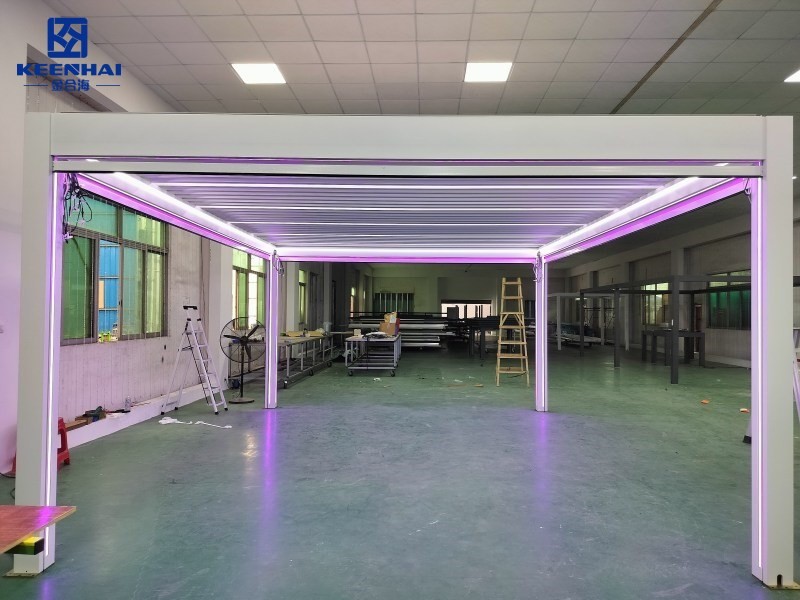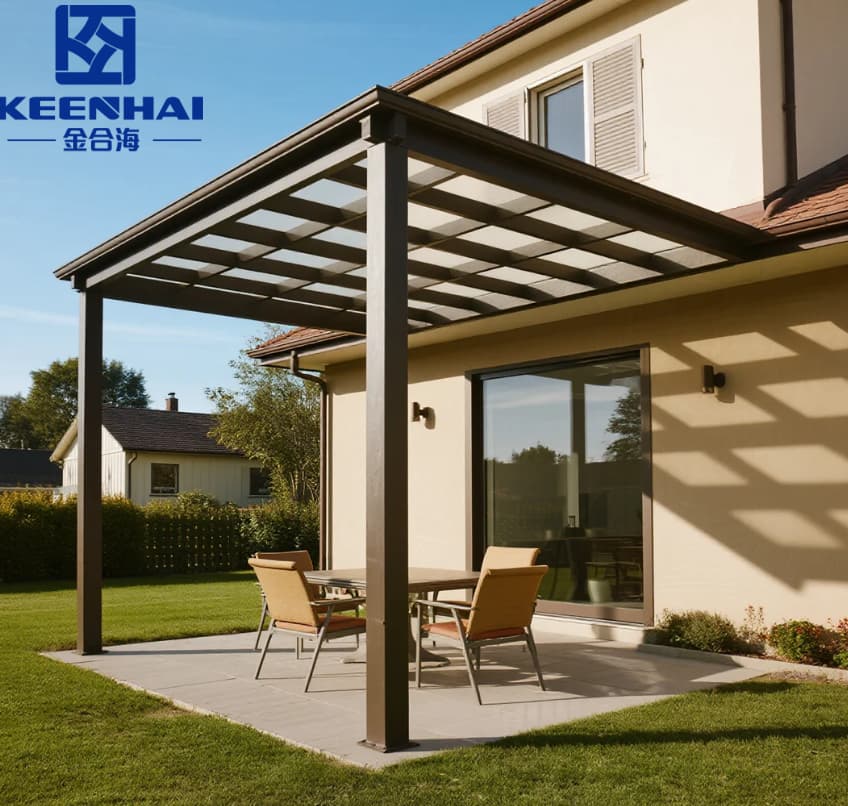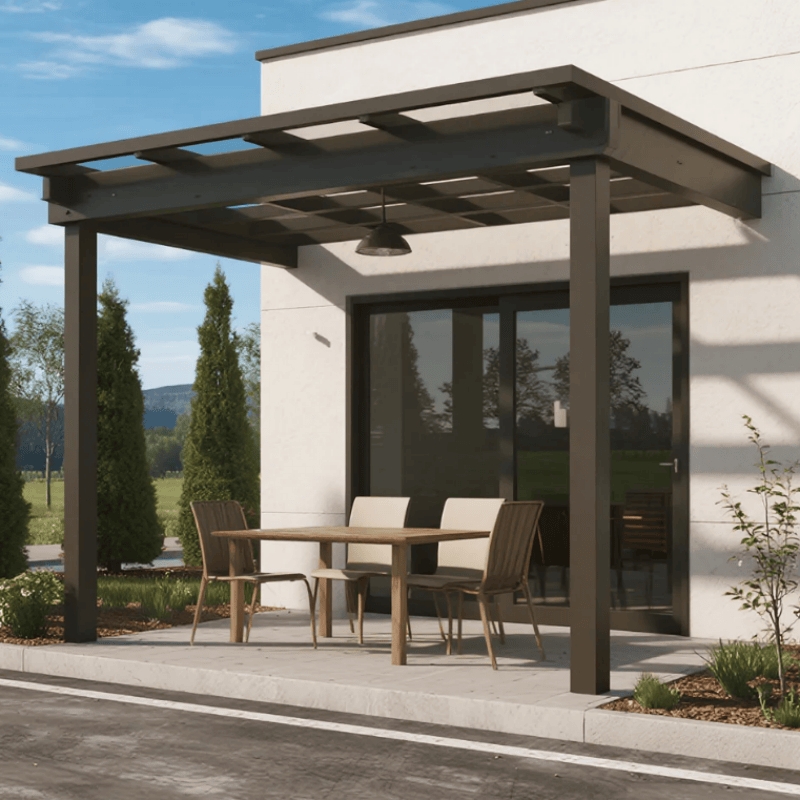
Material Properties and Durability
Aluminum Pergola: Strength and Weather Resistance
Aluminum pergolas are renowned for their strength, light weight, and resistance to weathering. Unlike wood, aluminum doesn’t warp, crack, or rot, making it ideal for areas with intense sun, rain, or humidity. Homeowners often pick aluminum for low maintenance and long-lasting modern designs.
For instance, a homeowner installed a modern aluminum prefab pergola over their deck. Even after multiple rainy seasons and summer heatwaves, the structure remained perfectly aligned, showing zero signs of rust or wear. This makes aluminum pergolas particularly appealing for those who want durable, hassle-free outdoor structures.
Wood Pergola: Natural Charm and Longevity
Wood pergolas bring warmth and classic elegance to any garden or patio. Hardwoods like cedar, teak, or redwood naturally resist decay but require regular maintenance—such as sealing or staining—to maintain both durability and appearance. They’re perfect for homeowners who value natural aesthetics and traditional craftsmanship.
For example, a backyard redwood pergola with climbing roses provided a shaded reading nook. Owners applied protective stains annually and ensured proper ventilation around beams, keeping the wood strong and visually appealing for years.
Comparison Table: Aluminum vs Wood
| Feature | Aluminum Pergola | Wood Pergola |
|---|---|---|
| Durability | Excellent; resistant to rot and warping | Good; depends on wood type and maintenance |
| Weather Resistance | High; powder-coated finish prevents rust | Moderate; requires sealing/staining |
| Maintenance Requirements | Low; occasional cleaning | High; annual upkeep recommended |
| Weight & Handling | Lightweight; easy to install | Heavier; careful handling needed |
| Lifespan | 20+ years | 15–25 years depending on care |
| Design Flexibility | Modern, customizable | Natural, classic |
A bioclimatic pergola or louvered aluminum system can further enhance outdoor comfort by controlling sunlight and airflow. Using such systems ensures both functionality and durability, making outdoor living spaces more enjoyable without adding maintenance headaches.

Maintenance and Upkeep
Cleaning and Care for Aluminum Pergolas
Aluminum pergolas are low-maintenance structures, but they still benefit from occasional cleaning to keep them looking pristine. A simple wash with mild soap and water every few months removes dust, pollen, or bird droppings. For homeowners who want modern outdoor louvered systems that adjust for sunlight, it's crucial to check the louvers periodically to ensure they operate smoothly.
For example, one homeowner installed a bioclimatic pergola over their patio. They schedule a quick rinse every two months and inspect screws and hinges. After three years, the structure still looks brand-new, demonstrating that aluminum’s durability paired with light upkeep makes it a smart investment.
Cleaning and Care for Wood Pergolas
Wood pergolas demand a bit more attention but reward you with timeless beauty and warmth. Hardwoods like cedar or teak require annual sealing or staining to prevent cracks, rot, and insect damage. Owners should also trim nearby plants and vines to avoid excessive moisture buildup.
Scenario: A backyard redwood pergola supporting wisteria was maintained with annual sealant applications. The homeowners also lightly sanded rough spots and removed debris from joints. Over five summers, the pergola remained sturdy and visually appealing, showing that consistent care preserves both longevity and aesthetics.
Long-Term Maintenance Costs
When planning a pergola, consider the cumulative cost of upkeep:
| Maintenance Aspect | Aluminum Pergola | Wood Pergola |
|---|---|---|
| Cleaning | Occasional soap and water | Weekly to monthly cleaning |
| Protective Treatments | Rare; optional wax or coating | Annual sealing/staining |
| Repairs | Minimal; usually screws or fasteners | Moderate; wood may crack or warp |
| Expected Maintenance Cost (5 yrs) | Low | Medium to High |
A custom louvered pergola design can slightly increase initial costs but often reduces long-term maintenance because the high-quality materials resist weathering. Considering both upfront and ongoing care, aluminum pergolas offer predictable, low-maintenance performance, while wood requires more effort but delivers a classic, natural look.

Aesthetic Appeal and Design Flexibility
Modern and Sleek Look of Aluminum Pergolas
Aluminum pergolas bring a clean, contemporary vibe to any outdoor space. Their slim profiles, powder-coated finishes, and customizable louvers allow homeowners to create visually striking patios or rooftop terraces. A modern aluminum gazebo installed on a city rooftop transformed the area into a sleek lounge space with adjustable shading, perfect for both morning coffee and evening entertaining.
The smooth surfaces and minimalist design also make aluminum structures highly compatible with modern furniture and lighting systems, enhancing both functionality and aesthetic appeal without adding bulk.
Warm and Natural Look of Wood Pergolas
Wood pergolas convey timeless elegance and warmth. The rich textures and natural tones of cedar, teak, or redwood blend seamlessly with gardens and landscaping, creating inviting spaces for relaxation. For example, a garden pergola tucked among flowering shrubs became a serene retreat for reading and outdoor dining, demonstrating how wood adds character and intimacy that aluminum sometimes cannot replicate.
Proper finishing, such as staining or oiling, enhances the wood’s natural grain and highlights architectural details, ensuring the structure continues to impress year after year.
Customization Options and Finishes
Whether choosing aluminum or wood, customization opens a world of possibilities. Aluminum pergolas can feature louvered roofs, integrated lighting, or motorized sunshades, while wood allows for carved beams, decorative trim, and personalized stains.
Scenario: A homeowner requested a custom louvered pergola design for their backyard deck. The team incorporated adjustable louvers, built-in lighting, and sleek metal posts, resulting in a versatile structure that suited both daytime sun control and evening ambiance. By selecting finishes and features carefully, any pergola can reflect personal style while enhancing outdoor functionality.

Cost Considerations and Value
Initial Investment for Aluminum vs Wood
Aluminum pergolas generally require a higher upfront investment than standard wood structures, primarily due to the cost of powder-coated aluminum, louvered systems, and precision manufacturing. However, homeowners investing in a custom louvered pergola design often find that the initial cost is justified by low maintenance and long-term durability.
Wood pergolas, on the other hand, tend to be less expensive initially but require careful selection of hardwood like cedar or teak to maximize lifespan. Improperly chosen or untreated wood can lead to warping, cracking, and premature repairs, which adds hidden costs over time.
Long-Term ROI and Durability Benefits
When considering ROI, aluminum pergolas outperform wood in most climates due to their resilience against rot, insects, and UV damage. Investing in high-quality materials and finishes ensures minimal maintenance while keeping the structure visually appealing for decades.
Scenario: A homeowner installed an aluminum pergola with adjustable louvers for both sun control and rain protection. After 5 years of daily exposure to sun and heavy rain, they spent only a few hours on cleaning, avoiding the annual sealing and repairs required for a comparable wood pergola. This demonstrates how higher upfront costs can translate into long-term savings.
Installation Complexity and Expenses
Installation complexity influences both cost and project planning:
-
Site Preparation – Level the ground, ensure proper drainage, and confirm measurements.
-
Foundation and Anchoring – For aluminum pergolas, concrete footings and metal anchors are used to ensure stability. Wood requires post holes, gravel, and sometimes additional bracing.
-
Assembling Components – Aluminum systems often arrive pre-fabricated for easier assembly, while wood may require cutting, sanding, and custom fitting.
-
Finishing Touches – Powder-coated aluminum may need minimal finishing, whereas wood requires staining or sealing to protect against weather.
A well-installed Aluminum pergola house can be up and running in a weekend with the right tools and team, while a custom wood pergola might take several days to a week depending on complexity and labor availability. The combination of pre-fabrication, lightweight materials, and modular design often reduces installation errors and labor costs, making aluminum a practical choice for homeowners who want efficiency and durability.
